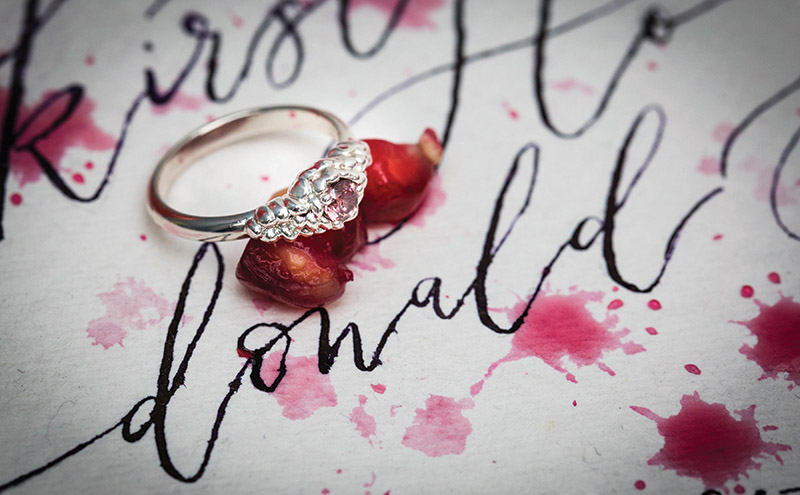Some leading jewellers talk us through finding and financing your bands

By Rosalind Erskine
Buying engagement and wedding rings is a big deal – they are expensive, massively symbolic and you’re going to have them for the rest of your life. How on earth do you go about choosing them?
1. Only deal with reputable firms
Even if you’re hoping to buy from a well-known name or brand, it’s important to try to visit their shop and take a look at the quality and range of rings on offer.
“If possible, hold, feel and try on some of the jeweller’s rings before you buy – it will give you a much better idea of the quality, finish and weight of the rings you like, and how the design will look and feel on your finger,” says Orkney-based designer Sheila Fleet.
2. Consider metals
Diamond solitaires and plain gold bands are classics, and for good reason, but there are many more options to explore.
Sheila explains: “Gold is available in three colours, yellow, white and rose, and in different degrees of purity, known as carat – the higher the carat the more gold there is [24ct gold is almost 100% pure – which makes it very expensive but also very soft; 18ct gold is around 75% pure – a good compromise between purity and strength].
“Palladium and platinum are the other metals we use. Both are harder and heavier than silver or gold. They will not tarnish over time and are very durable. They’re also both hypoallergenic.”
“Your wedding band is most likely going to be worn every day, so the metal needs to suit your lifestyle,” points out Richard Laing, of Laings Edinburgh. “If you work in an environment where your ring could easily get caught or knocked, you should consider a harder-wearing metal that won’t scratch easily.”
3. Set a budget – and stick to it
Before you start looking at rings, work out what you can afford and discuss this early on so you’re not wasting time eyeing up something only a Kardashian could afford.
Jane Fleming, a designer at Celtic Art, recommends being upfront when it comes to money: “Never be embarrassed to say how much you want to spend, regardless of how large or small a sum it may be. A good designer will want to work to your budget – telling them what you plan to spend means they can advise you properly about metal, stones and labour costs,” she says.


4. Match your metals
You might think the old unwritten rule about not wearing silver and gold rings together is one you can dismiss – what difference does it make? Actually, there’s a solid reason behind it, as Julia Black, jeweller and designer at James Brown and Partners in Glasgow explains: “Buy a wedding band in the same metal as your engagement ring – in other words, if your engagement ring is 18ct white gold, go for an 18ct white gold wedding band. If they’re different metals (say, one platinum and one 9ct white gold), they will wear at different rates, and over time the difference will become obvious.”
5. Give yourself plenty of time
This is particularly important if you’re getting your rings made bespoke, which can take from four to six weeks upwards. Discuss timescales with your jeweller, as every design will be different.
“It’s even better if you can allow at least six to eight weeks from ordering to completion of bespoke items,” says Jane.
“We make everything to order at Celtic Art, and this timetable allows for the design work and processing of the order, any CAD work and fabrication, casting, ordering and setting of stones, finishing and polishing the piece. All of our jewellery is made here in Scotland, and it all bears the prestigious Edinburgh hallmark.”
6. Learn about stones – size does not equal quality
Diamonds – it’s all about the bling, isn’t it? Not at all, says Richard. “To the untrained eye, a diamond is a sparkly stone, but there’s a lot more to consider. As well as the famous five Cs (colour, clarity, carat, cut and certification) that indicate a diamond’s quality, there are three key factors that we focus on and which a Laings diamond must demonstrate: superior performance, no marks or flaws that could cause a future problem and good value.”
7. Visit a workshop
A visit to a jeweller’s workshop can be a fun, informative way to find out more about how rings are made – and a chance to gain precious inspiration for a unique piece of jewellery of your own.
James Brown and Partners welcomes visitors as Julia lays out: “Before you make a purchase, come to the workshop and get advice from a jeweller about which styles will suit you best. Nobody knows the pros and cons of wedding band choices better than the people who are actually making the rings!”


8. Some rings will need resizing
You might not think it, but it’s more than likely your fingers will change size over the course of your life, and your rings may not fit as well as they did when new. Most rings can be resized – but not all, as Julia explains: “Certain metals are very difficult to work with, such as titanium and tungsten, and buying a wedding ring in these metals means that it can never be resized or repaired.”
Stones also make a difference: “If the wedding band is diamond-set, make sure it’s a style that can be sized,” she says. “Diamonds going the full way around the band normally mean that it can’t be resized.”
9. Band width is important
A wide, plain band is best for a man’s ring – isn’t it? Not really, says Julia. “The problem is that wide, plain bands show general wear and scratches more easily – simply because there is more metal visible. If it’s white gold, it’ll also show more discolouration for that reason. If it’s a white metal you want, look at palladium instead. It’s similar in price to white gold, but has all the benefits of platinum and is really hardwearing.”
10. Trust your instincts
“This is a ring that’s probably going to be worn every day for the rest of your life, so you want it to be durable and practical as well as beautiful,” says Jane. “So when you are choosing the design, go with your gut. It’s important for the jeweller to guide you in terms of the practicalities of the design options, but ultimately it’s your choice. So arm yourself with knowledge and that way you will be able to rest assured you’ve made the correct decision for the right reasons.”







